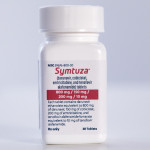Prezista (darunavir) may be approved only for treatment-experienced patients, but new data suggest that it may also have a lot to offer those starting treatment for the first time. Norvir (ritonavir)-boosted Prezista is comparable to Kaletra (lopinavir plus ritonavir), with a few possible side-effect advantages and better efficacy among patients beginning treatment with high viral loads, according to study results reported today at the 47th Interscience Conference on Antimicrobial Agents and Chemotherapy (ICAAC) in Chicago.
Tibotec’s ongoing ARTEMIS study is comparing an experimental once-daily dose of Prezista (800mg) plus Norvir (100mg) to once- or twice-daily Kaletra in 689 HIV-positive patients beginning their first antiretroviral drug regimens. All patients in the study also took Truvada (tenofovir plus emtricitabine). The 48-week results from the study were reported at ICAAC by Edwin DeJesus, MD, medical director of the Orlando Immunology Center.
At the start of the study, patients’ viral loads averaged 70,800 in the Prezista/Norvir group and 62,100 in the Kaletra group. CD4 counts averaged 228 and 218 cells, respectively. Approximately 36 percent of the patients in both study groups began treatment with high viral loads—in excess of 100,000 copies.
According to Dr. DeJesus, 12 percent of those in the Prezista group and 16 percent of those in the Kaletra group prematurely discontinued therapy. Approximately 3 percent taking Prezista discontinued due to side effects, compared to roughly 7 percent of those taking Kaletra.
Across the board, 84 percent of the Prezista-treated patients had viral loads below 50 copies after 48 weeks, compared to 78 percent of those in the Kaletra group. Because there was no statistically significant difference between the two groups—meaning that it could have been due to chance—once-daily Norvir-boosted Prezista was concluded to be “non-inferior” to Kaletra.
Norvir-boosted Prezista did show an advantage over Kaletra in patients who entered ARTEMIS with high viral loads. Among those who entered the study with viral loads below 100,000 copies, 86 percent in the Prezista group and 85 percent in the Kaletra group had viral loads below 50 copies after 48 weeks. But among those who started the study with viral loads of 100,000 or greater, 79 percent in the Prezista group had undetectable viral loads after 48 weeks, compared with only 67 percent of those in the Kaletra group. This difference was statistically significant.
Dr. DeJesus also hinted at the possibility that once-daily Prezista/Norvir has an efficacy advantage over once-daily Kaletra. Compared with the 84 percent of Prezista-treated patients with viral loads below 50 copies after 48 weeks, 71 percent of the once-daily Kaletra-treated patients achieved similar responses. Among those taking twice-daily Kaletra, the success rate was 81 percent. It is important to note, however, that ARTEMIS was not designed to make these comparisons—coupled by the fact that only 15 percent of patients in the Kaletra group were taking the drug once daily—making a statistical comparison very difficult.
Gains in CD4 counts were similar in both groups. There was a 141-cell gain in the Kaletra group after 48 weeks, compared to a 137-cell increase in the Prezista/Norvir group.
As for side effects, gastrointestinal (GI) problems, including diarrhea, were more likely to occur in the Kaletra group than in the Prezista/Norvir group. GI events occurred in 14 percent of those taking Kaletra and 7 percent of those taking Prezista/Norvir. Diarrhea was documented in 10 percent of those in the Kaletra group, compared with 4 percent of those in the Prezista group. While these differences were statistically significant, it is worth noting that most patients in the Kaletra group were receiving an older capsule formulation of the drug that is known to cause more gastrointestinal problems than the newer tablet version.
Differences in lipid changes were reported as well. Moderate-to-severe increases in total cholesterol were found in 23 percent of those in the Kaletra group, compared with 13 percent of those in the Prezista group. Similarly, moderate-to-severe increases in triglycerides occurred in 11 percent of Kaletra takers, compared with 3 percent of those receiving Prezista/Norvir.
In conclusion, Dr. DeJesus said that once-daily Norvir-boosted Prezista, combined with Truvada, “resulted in excellent virologic and immunologic responses” and that it is “well tolerated with a favorable safety profile.” He added that compared with Kaletra, Prezista combined with Norvir “was non-inferior in the overall population, and superior in patients with high viral loads, with a lower incidence of common GI toxicities and triglyceride elevations.”
Source:
DeJesus E, Ortiz R, Khanlou H, et al. Efficacy and safety of darunavir/ritonavir versus lopinavir/ritonavir in ARV treatment-naïve HIV-1-infected patients at week 48: ARTEMIS [Abstract H-718b]. 47th Conference on Antimicrobial Agents and Chemotherapy, Chicago, 2007.






Comments
Comments